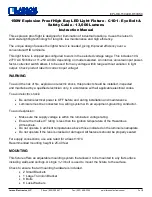
2
CHAPTER 2
:
MAINTENANCE & SAFETY
IMPORTANT SAFETY INFORMATION
It is the sole responsibility of the purchaser of MATRIX products to instruct all individuals, whether
they are the end user or supervising personnel on proper usage of the equipment.
It is recommended that all users of MATRIX exercise equipment be informed of the following
information prior to its use.
Do not use any equipment in any way other than designed or intended by the manufacturer. It is
imperative that MATRIX equipment be used properly to avoid injury.
INSTALLATION
STABLE AND LEVEL SURFACE: MATRIX exercise equipment must be installed on a stable base
and properly leveled.
SECURING EQUIPMENT: Manufacturer recommends that all stationary MATRIX strength
equipment be secured to the floor to stabilize equipment and eliminate rocking or tipping over. This
must be performed by a licensed contractor.
Under no circumstances should you slide equipment across the floor due to risk of tipping. Use
proper materials handling techniques and equipment recommended by OSHA. All anchor points
must be able to withstand 750 lbf. (3.3 kN) pull-out force.
MAINTENANCE
DO NOT use any equipment that is damaged and or has worn or broken parts. Use only
replacement parts supplied by your country’s local MATRIX dealer.
MAINTAIN LABELS AND NAMEPLATES: Do not remove labels for any reason. They contain
important information. If unreadable or missing, contact your MATRIX dealer for a replacement.
MAINTAIN ALL EQUIPMENT: Preventative maintenance is the key to smooth operating equipment
as well as keeping your liability to a minimum. Equipment needs to be inspected at regular
intervals.
Ensure that any person(s) making adjustments or performing maintenance or repair of any kind is
qualified to do so. MATRIX dealers will provide service and maintenance training at our corporate
facility upon request.
ADDITIONAL NOTES
This equipment should only be used in supervised areas where access and control is specifically
regulated by the owner. It is up to the owner to determine who is allowed access to this training
equipment. The owner should consider a user’s: degree of reliability, age, experience, etc.
This training equipment meets industry standards for stability when used for its intended purpose in
accordance with the instructions provided by the manufacturer.
This equipment is for indoor use only. This training equipment is a Class S product (designed for
use in a commercial environment such as a fitness facility). This training equipment is in
compliance with EN ISO 20957-1 and EN 957-2.






























